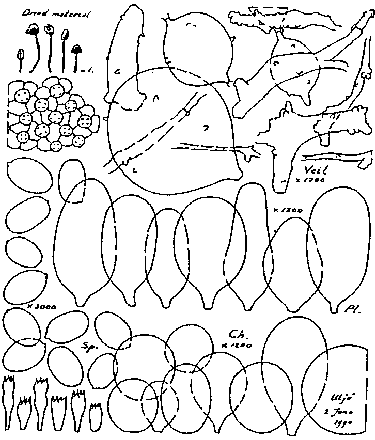Macroscopic features |
Closed pileus ellipsoid or cylindrical ellipsoid, up to 13 mm high and 3-8 mm wide, completely covered with creamy-white, later pale greyish-ochre, powdery veil (according to the description of Watling (l.c.) the pileus is covered throughout with pale grey scurfy sheath-like veil with a faint flush of ochraceous; finally the pileus is evenly sepia with remnants of the veil in irregular patches flushed with ochraceous); veil at margin, particularly in early stages somewhat more hairy-floccose; expanded pileus 10-25 mm wide, first conical or campanulate, later applanate with reflexed margin. Lamellae free, white at first then grey (violaceous grey according to Watling) then black with pale edge. Stipe up to 50 x 1-2 mm, attenuate upwards, white to greyish, with small velar flocks, at base somewhat swollen, white hairy-flocculose. Smell absent. Spore print violaceous black. |
Microscopic features |
Spores [20,1,1] 6.0-7.7 x 4.2-5.0 x 4.1-4.5 µm, Q = 1.35-1.70, av. Q = 1.50; av. L = 7.0, av. B = 4.7 µm, cylindrical-ellipsoid in frontal view, ellipsoid in side-view, red-brown, with central, truncate germ pore, difficult to see. Basidia 10-22 x 6-8 µm, 4-spored, surrounded by 3-5 pseudoparaphyses. Pleurocystidia 30-55 x 15-35 µm, ellipsoid, utriform, vesiculose or subcylindric. Cheilocystidia 20-50 x 15-35 µm, ellipsoid or (sub)globose. Veil made up of (sub)globose elements, 25-60 µm in diam., mixed with fusiform or elongate, 2-15 µm wide elements. Clamp-connections present. |
Habitat & distribution |
Solitary or a few together. On dung of sheep, cow and horse. Very rare in the Netherlands (One found). |
Remarks |
Coprinus utrifer is microscopically easy to identify by its small subcylindrical spores. Some measurements in literature appear to be slightly different: spores (Watling: 7.5-8.5[-9.0] x 4.5-5.5 µm; Josserand: 7.8-8.8 x 4.6-5.3[-5.5] µm); pleurocystidia (Watling: 40-100 x 17-23 µm; Josserand: 60-100 x 20-30 µm), cheilocystidia (Watling: 25-40 x 25-35 µm; Josserand (15-)25-40 x 10-20 µm), but we think the Estonian collection studied fits well in the concept of Coprinus utrifer. |

[Copyright © by ]